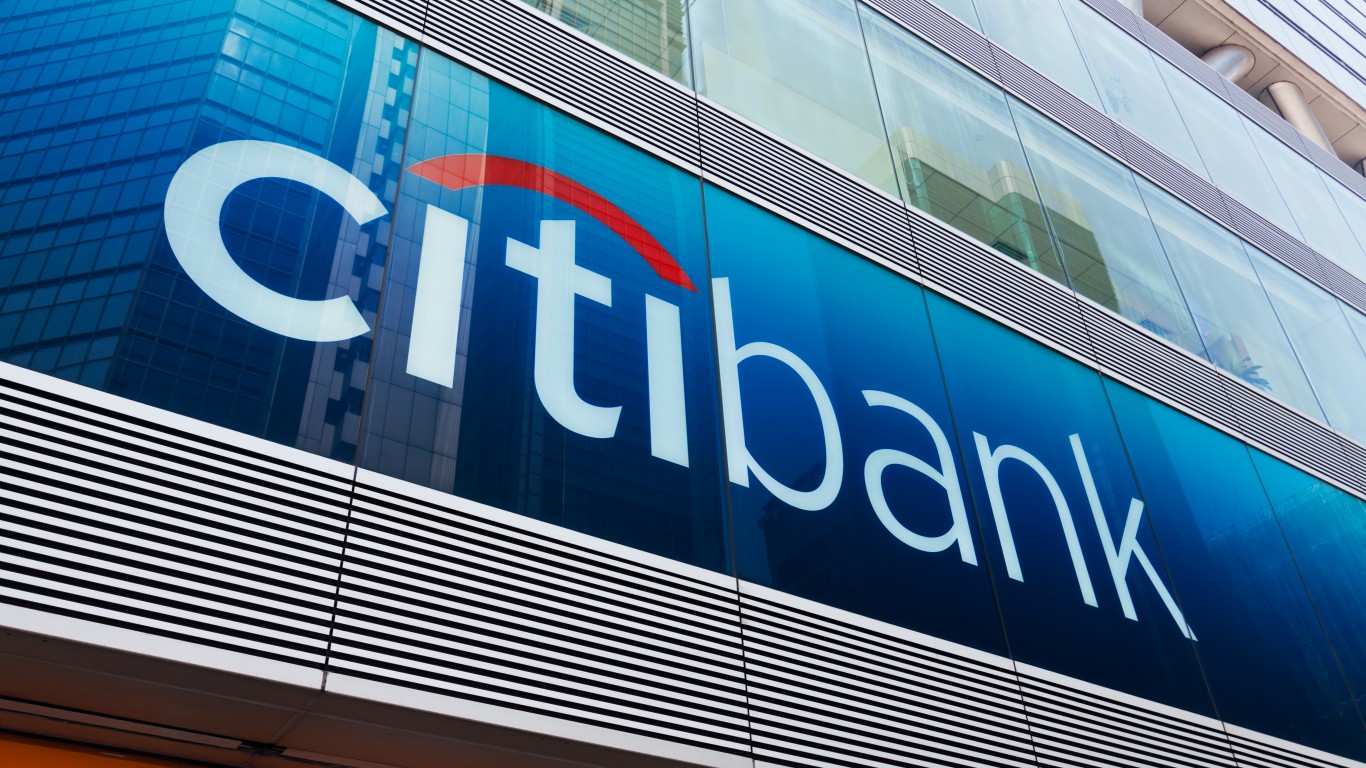
Shortly after Wednesday’s opening bell, the Dow traded up 0.48%, the S&P 500 up 0.57% and the Nasdaq 0.77% higher. The March consumer price index report shaved another point from its year-over-year rate, from up 6% in February to up 5% last month. The numbers are raising hopes of an easing of the Federal Reserve’s rate hikes. The next Federal Open Market Committee meeting begins May 2.
No notable earnings reports were released after markets closed Tuesday or before they opened on Wednesday.
First thing Thursday morning, Delta Air Lines, Infosys and Progressive are expected to post their quarterly results.
Here are previews of three of the nation’s largest banks, all on deck to report quarterly results before U.S. markets open on Friday.
Citigroup
The fifth-largest U.S. bank (by market cap), Citigroup Inc. (NYSE: C) stock has added about 4.7% to its share price over the past 12 months. Since March 9, the day that Silicon Valley Bank began to show signs of its impending failure, Citi stock has retreated by 7.6%, about in the middle of the losses posted since that date by the biggest U.S. banks.
The big question for banks heading into this earnings season is whether they can remain profitable in the face of slower lending growth, increased saving and higher credit costs. All these issues will affect share buybacks as well. Citi recently said it expected net interest income for the 2023 fiscal year to come in at around $45 billion, some $5 billion short of the consensus estimate.
Of 24 brokerages covering the company, nine have a Buy or Strong Buy rating and 14 have Hold ratings. At a recent price of around $47.20 a share, the upside potential based on a median price target of $53.00 is 12.3%. At the high price target of $75.00, the upside potential is about 58.9%.
First-quarter revenue is forecast at $20.09 billion, which would be up 11.6% sequentially and by 4.7% year over year. Adjusted earnings per share (EPS) are forecast at $1.68, up 44.7% sequentially but down 20.2% year over year. For the full 2023 fiscal year, analysts anticipate EPS of $5.90, down 17.1%, on revenue of $77.89 billion, up 3.4%.
Citigroup stock trades at 8.0 times expected 2023 EPS, 7.1 times estimated 2024 earnings of $6.67 and 6.2 times estimated 2025 earnings of $7.56. The stock’s 52-week trading range is $40.01 to $54.56, and Citi pays an annual dividend of $2.04 (yield of 4.39%). Its total return to shareholders for the past year was negative 2.66%.
JPMorgan
The largest (by market cap) of the big U.S. banks, JPMorgan Chase & Co. (NYSE: JPM) has seen a share price decline of about 3.4% over the past 12 months. Like the other big banks, JPMorgan posted a year-to-date low in late March, following the turmoil in the regional banking industry.
In his annual letter to shareholders, JPMorgan CEO Jamie Dimon said, “The current crisis is not yet over, and even when it is behind us, there will be repercussions from it for years to come.” If inflation should rise to around 6% (as Dimon predicted in January), the big banks almost certainly will have to boost loan-loss reserves by significant amounts, cutting into profitability.
Of 26 analysts covering the stock, 18 have a Buy or Strong Buy rating, while the other eight rate it at Hold. At a share price of around $128.50, the upside potential based on the median price target of $150.00 is 16.7%. At the high price target of $179.00, the upside potential is 39.3%.
Analysts expect JPMorgan to report first-quarter revenue of $35.68 billion, up by 3.3% sequentially and 16.1% higher year over year. Adjusted EPS are forecast at $3.35, down 6.1% sequentially but up 27.4% year over year. For the full 2023 fiscal year, current estimates call for EPS of $12.62, down 4.4%, on revenue of $139.68 billion, up 8.5%.
JPMorgan stock trades at 10.2 times expected 2023 EPS, 9.9 times estimated 2024 earnings of $12.92 and 9.6 times estimated 2025 earnings of $13.36. Its 52-week range is $101.28 to $144.34. JPMorgan pays an annual dividend of $4.00 (yield of 3.13%). Total shareholder return for the past 12 months was negative 0.14%.
Wells Fargo
Wells Fargo & Co. (NYSE: WFC) is the nation’s third-largest bank, and its share price has dipped by 20.2% over the past 12 months. Since early March, the stock is down by 16%. Net interest income is expected to rise by 10.3% year over year in 2023, assuming modest loan growth. The risk for Wells Fargo is that its credit losses could be worse than that of its peers, leading to even higher reserves and lower profitability.
Analysts remain bullish about Wells Fargo. Of 26 brokerages covering the bank, seven have a Hold rating and 19 have Buy or Strong Buy ratings. At a share price of around $39.40, the upside potential based on a median price target of $47.58 is 20.8%. At the high price target of $58.00, the upside potential is about 49.7%.
Analysts expect first-quarter revenue to total $20.07 billion, up 2.1% sequentially and by 14.1% year over year. Adjusted EPS are forecast at $1.16, down 20% sequentially but 31.8% higher year over year. For the full 2023 fiscal year, EPS are forecast to rise by 7.8% to $4.80, and revenue is expected to increase by 7.5% to $79.28 billion.
Wells Fargo stock trades at 8.2 times expected 2023 EPS, 7.9 times estimated 2024 earnings of $5.00 and 7.9 times estimated 2025 earnings of $5.00. The stock’s 52-week range is $35.25 to $49.90. Wells Fargo pays an annual dividend of $1.20 (yield of 3.11%), and total shareholder return for the past 12 months is negative 18.16%.
Want to Retire Early? Start Here (Sponsor)
Want retirement to come a few years earlier than you’d planned? Or are you ready to retire now, but want an extra set of eyes on your finances?
Now you can speak with up to 3 financial experts in your area for FREE. By simply clicking here you can begin to match with financial professionals who can help you build your plan to retire early. And the best part? The first conversation with them is free.
Click here to match with up to 3 financial pros who would be excited to help you make financial decisions.
Thank you for reading! Have some feedback for us?
Contact the 24/7 Wall St. editorial team.
 24/7 Wall St.
24/7 Wall St.


